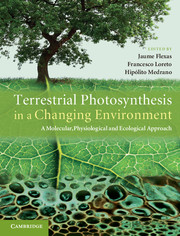 Terrestrial Photosynthesis in a Changing Environment
Terrestrial Photosynthesis in a Changing Environment Book contents
- Frontmatter
- Contents
- List of contributors
- Preface
- Acknowledgements
- List of abbreviations
- 1 Terrestrial photosynthesis in a changing environment
- Part I Photosynthesis
- 2 Biochemistry and photochemistry of terrestrial photosynthesis: a synopsis
- 3 Photosynthetic regulation
- 4 Interactions between photosynthesis and day respiration
- 5 The ecophysiology and global biology of C4 photosynthesis
- 6 Ecophysiology of CAM photosynthesis
- 7 Special photosynthetic adaptations
- 8 Models of photosynthesis
- Part II Measuring photosynthesis
- Part III Photosynthetic response to single environmental factors
- Part IV Photosynthesis in time
- Part V Photosynthesis in space
- Part VI Photosynthesis in a global context
- References
- Index
4 - Interactions between photosynthesis and day respiration
Published online by Cambridge University Press: 05 March 2013
- Frontmatter
- Contents
- List of contributors
- Preface
- Acknowledgements
- List of abbreviations
- 1 Terrestrial photosynthesis in a changing environment
- Part I Photosynthesis
- 2 Biochemistry and photochemistry of terrestrial photosynthesis: a synopsis
- 3 Photosynthetic regulation
- 4 Interactions between photosynthesis and day respiration
- 5 The ecophysiology and global biology of C4 photosynthesis
- 6 Ecophysiology of CAM photosynthesis
- 7 Special photosynthetic adaptations
- 8 Models of photosynthesis
- Part II Measuring photosynthesis
- Part III Photosynthetic response to single environmental factors
- Part IV Photosynthesis in time
- Part V Photosynthesis in space
- Part VI Photosynthesis in a global context
- References
- Index
Summary
Introduction
Although the general metabolic schemes of photosynthetic and respiratory pathways are well known when considered as separate entities, their interactions are one of the conundrums of plant photosynthetic biology. However, such interactions are the cornerstone for nitrogen assimilation by leaves, simply because carbon assimilation produces organic materials (carbohydrates) that are converted to nitrogen acceptors by respiration. Unsurprisingly then, intense efforts are currently devoted to elucidate the metabolic basis of reciprocal influences of photosynthesis and respiration, with the optimisation of nitrogen assimilation for a better yield of crop plants as an ultimate goal (Lawlor, 2002). From a basic science point of view, the interactions between respiration and photosynthesis have been a matter of interest for more than a century. The very first experiments were reported by Pizon (1902): ‘The respiration rate appears to be decreased by light. In fact, the quantity of CO2 evolved by button mushrooms (Agaricus bisporus) in the light is always smaller than that evolved in darkness. It is generally the same for green plants; however, difficulties remain to precisely assess the difference between respiratory rates in the light and in the dark, because chl.-dependent assimilation occurs in the light and one does not know how to accurately separate both phenomena.’
As emphasised by Pizon (1902), one major difficulty stems from the limited technical possibilities to measure the rate of day respiration (CO2 evolution in the light produced by respiration, as opposed to night respiration, i.e., the CO2 evolution in darkness or Rn), and importantly, from the impossibility to isolate and purify such respired CO2 molecules for example, 14C or 13C isotopic analyses. Several techniques (gas-exchange or 12C/13C techniques) have been developed over nearly 30 years to overcome this difficulty, and they are summarised below. As such, it is currently believed that photosynthesis is accompanied by lower respiration rates (inhibition of day respiration). Molecular techniques have also provided the evidence that the respiratory metabolism changes somewhat during photosynthesis in illuminated leaves, and this correlates with the operation of nitrogen and redox metabolism. At the whole-plant level, respiration is responsible for major carbon losses, but there is now a large body of evidence showing that plant growth and development is also sustained by respiration. Therefore, respiration is often viewed as beneficial for plant carbon gain at both leaf and plant levels.
- Type
- Chapter
- Information
- Terrestrial Photosynthesis in a Changing EnvironmentA Molecular, Physiological, and Ecological Approach, pp. 41 - 53Publisher: Cambridge University PressPrint publication year: 2012
- 6
- Cited by


